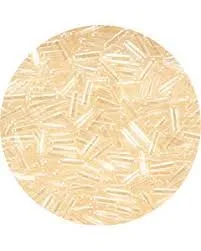
Nov . 11, 2024 23:55 Back to list
propyl methyl cellulose
Understanding Propyl Methyl Cellulose Properties, Applications, and Benefits
Propyl Methyl Cellulose (PMC) is a versatile cellulose ether with a wide range of applications across various industries. Derived from natural cellulose, PMC is chemically modified to enhance its properties and expand its usability in several fields including pharmaceuticals, food production, cosmetics, and construction.
Chemical Structure and Properties
PMC is synthesized by the methylation and propylation of cellulose, which is obtained from plant cell walls. The chemical structure of PMC consists of a cellulose backbone with methoxy and propoxy groups attached. This modification alters the physical and chemical properties of cellulose, rendering it soluble in water and providing an array of functionalities based on the degree of substitution and viscosity.
One of the key features of PMC is its ability to form gels and emulsions, making it an essential ingredient in a variety of products. The solubility of PMC in water can be influenced by the temperature and pH, allowing for controlled release in pharmaceutical applications, or creating stable formulations in food products.
Applications in Pharmaceuticals
In the pharmaceutical industry, Propyl Methyl Cellulose serves as a key excipient. It is commonly used in tablet formulations where it acts as a binder, thickener, and film-forming agent. Its capability to form gels and retain moisture makes it suitable for controlling the release of active ingredients, providing extended-release properties in medications. Furthermore, PMC's biocompatibility and low toxicity enhance patient safety, making it a preferred choice for various formulations, including capsules and coatings.
Role in Food Production
In the food industry, PMC is valued for its thickening, emulsifying, and stabilizing properties. It is often found in sauces, dressings, and processed foods, where it aids in maintaining texture and improving mouthfeel. As a dietary fiber, Propyl Methyl Cellulose can contribute to the overall nutritional value of food products, offering functional benefits such as reduced fat and calorie content by replacing fats in formulations. Imported by many food manufacturers for its versatility, PMC helps to meet consumer demands for healthier, lower-calorie options without compromising quality.
propyl methyl cellulose

Applications in Cosmetics
The cosmetic industry also employs PMC due to its unique rheological properties. It can be found in lotions, creams, and gels, where it acts as a thickening agent and stabilizer. Its film-forming capabilities enhance the texture and application of cosmetic products while improving skin feel. Additionally, PMC offers moisture retention properties, making it an excellent addition to hydrating skincare products.
Construction and Other Uses
In construction, Propyl Methyl Cellulose serves as a water-retaining agent in mortars, plasters, and adhesives, improving workability and adhesion without affecting setting times. Its ability to retain moisture prevents cracking and enhances durability in building materials. PMC is also used in the production of paints and coatings, where it helps in achieving desired viscosity and stability during application.
Environmental Impact and Safety
From an environmental perspective, PMC is considered a safer alternative to synthetic polymers due to its natural origin and biodegradability. Although derived from cellulose, its chemical modifications are generally recognized as safe (GRAS) by regulatory bodies such as the FDA. This makes it an attractive option for manufacturers looking to adopt sustainable practices while ensuring product efficacy.
Conclusion
Propyl Methyl Cellulose is a significant cellulose ether with multifunctional properties that extend its applicability across various industries. From enhancing pharmaceutical formulations to providing stability in food and cosmetic products, PMC's versatility continues to drive innovation and meet the evolving needs of consumers. As industries prioritize safety and sustainability, the demand for natural, effective ingredients like PMC is likely to increase, paving the way for further research and development in this fascinating area of cellulose derivatives.
-
Versatile Hpmc Uses in Different Industries
NewsJun.19,2025
-
Redispersible Powder's Role in Enhancing Durability of Construction Products
NewsJun.19,2025
-
Hydroxyethyl Cellulose Applications Driving Green Industrial Processes
NewsJun.19,2025
-
Exploring Different Redispersible Polymer Powder
NewsJun.19,2025
-
Choosing the Right Mortar Bonding Agent
NewsJun.19,2025
-
Applications and Significance of China Hpmc in Modern Industries
NewsJun.19,2025







